My Top 10 Favorite D&D Monsters (Part I)
In the interests of narrowing the scope of potential candidates for this list, I established a few rules for myself. First and most importantly, I would only select from monsters unique to Dungeons & Dragons. That means, mythological or folkloric monsters, like minotaurs or goblins, were excluded from consideration, even in cases where D&D's version of them is idiosyncratic (e.g. kobolds). Second, monsters of a singular type, such as named demons or devils, were likewise excluded. Finally, any edition of Dungeons & Dragons was fair game, though, given my age and preferences, I hope no one will be surprised that all of the monsters I chose first appeared in either OD&D or AD&D 1e.
As with all of my previous Top 10 posts, this list comprises my personal favorites – a purely subjective category. I do not, therefore, suggest that any of these monsters are the "best" by any other measure. Indeed, several of those included, as you'll soon see, are, in fact, quite silly by any charitable definition, but I have a fondness for them born of more than four decades of play. No doubt many of you reading this will have your own favorites of a similar sort.
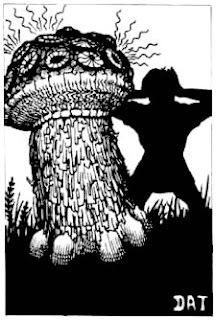 10. Shrieker
10. Shrieker
The shrieker is one of those silly monsters I mentioned earlier. It's a mindless, ambulatory fungus that emits a piercing shriek when either a light source is brought within 30' of its location or there is movement within 10'. The noise has a 50% chance of attracting wandering monsters each round that it shrieks. I first came across shriekers in the pages of the J. Eric Holmes-edited Basic Rules and, which may explain why I consider them – and fungi more generally – a quintessential aspect of the play of D&D. I suspect shriekers aren't very popular with most gamers, since they exist entirely to screw with reckless or incautious players. That's exactly why I do like them and include them in most of the dungeons I've made over the years.
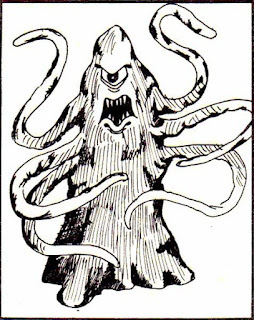
9. Roper
While I wouldn't call the roper "silly," it is a little goofy. It's also a little bit scary too, since, according to its description in the AD&D Monster Manual, it can disguise itself as a pillar or stalagmite in order to better attack its unsuspecting prey. Its natural form is that of a one-eyed slimy mass of arms with a huge fang-toothed maw. I wouldn't go so far as to say it's nightmarish, but it's definitely not something I'd like to encounter under any circumstances. On the plus side, it often has platinum pieces and gems in its gizzard, which is very D&D.
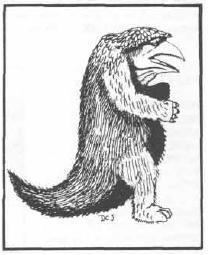 8. Owlbear
8. Owlbear
The owlbear is not a silly monster, as anyone familiar with either owls or bears could tell you. Unfortunately, its illustration by Dave Sutherland does little to convey just how terrifying such a creature would be, were it to exist in the real world. I like owlbears because they're just fantastical enough that they nicely convey the "we're not in Kansas anymore" vibe that any good fantasy setting should have, while also being sufficiently mundane that their widespread presence within the Forest of Doom doesn't seem implausible. Their existence also implies that wizards get up to weird stuff – another must have in any decent fantasy setting.
7. Carrion Crawler
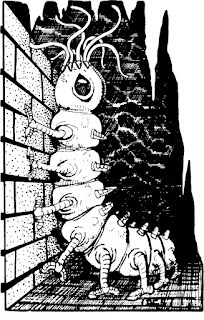 I am a well known enjoyer of vermin and the carrion crawler, as its name suggests, is a frightfully hopped up example of them. It's also, despite having only 3+1 Hit Dice, an exceptionally dangerous opponent. Each of its eight tentacles gets an attack and each is capable of inflicting paralysis with a hit on anyone unlucky enough to fail a saving throw. I can still vividly recall an early encounter with a carrion crawler that nearly resulted in a total party kill. That left my younger self with a healthy level of respect for carrion crawlers – not to mention the belief that they were perfect monsters to include in my own dungeons. Dave Sutherland depicts them in the Monster Manual as a kind of Cthulhoid caterpillar, which is bonkers in the way that the best D&D monsters should be.
I am a well known enjoyer of vermin and the carrion crawler, as its name suggests, is a frightfully hopped up example of them. It's also, despite having only 3+1 Hit Dice, an exceptionally dangerous opponent. Each of its eight tentacles gets an attack and each is capable of inflicting paralysis with a hit on anyone unlucky enough to fail a saving throw. I can still vividly recall an early encounter with a carrion crawler that nearly resulted in a total party kill. That left my younger self with a healthy level of respect for carrion crawlers – not to mention the belief that they were perfect monsters to include in my own dungeons. Dave Sutherland depicts them in the Monster Manual as a kind of Cthulhoid caterpillar, which is bonkers in the way that the best D&D monsters should be.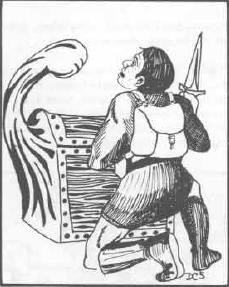 6. Mimic
6. Mimic
A lot of people seem to think the mimic is a silly monster, but they're wrong. Certainly the mimic owes its existence to a referee's desire to mess with thieves and that might rub some people the wrong way (mostly the players of thieves). On the other hand, mimics are (in my opinion) another fine example of wizards getting up to weird stuff and that's all to the good. My main regret about the mimic is that too many people seem to think they can only shapeshift into chests. That vastly underestimates their utility and I wish more referees included mimicked chairs, tables, doors, and so on in their dungeons. That said, the mimic chest is a classic for a reason, though Sutherland gets bonus points for eschewing the obvious and instead having the monster punch the hapless thief who got too close to it.
James Maliszewski's Blog
- James Maliszewski's profile
- 3 followers



